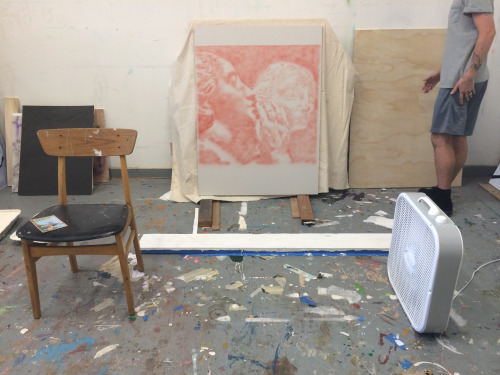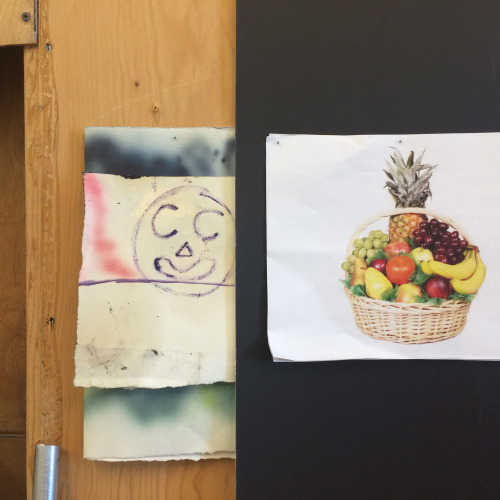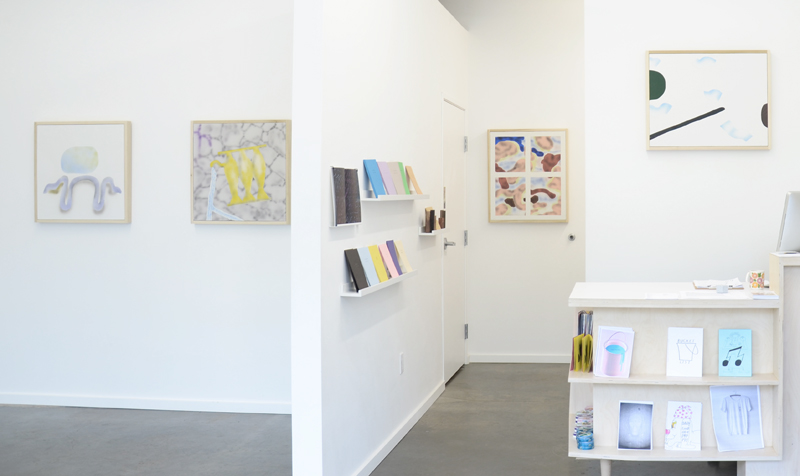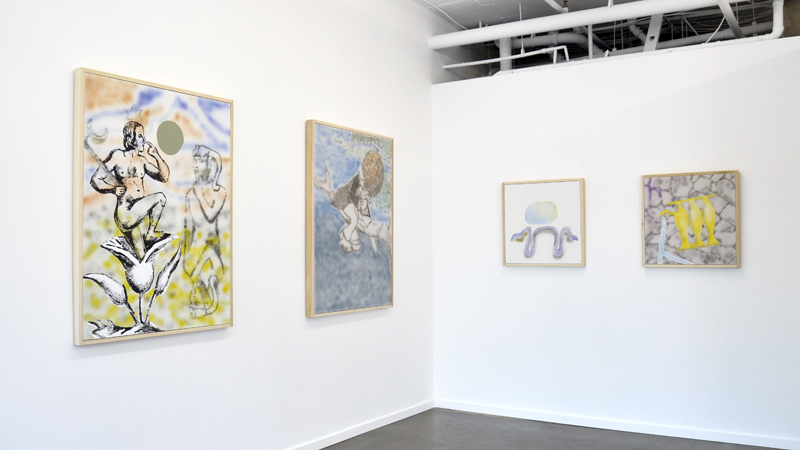Daniel Long shares a few insights on his current series at Nationale A Peanut in a Suit Is a Peanut Nonetheless while at his fellowship at Lighthouse Works on Fishers Island, NY. Thanks, Daniel!
Daniel’s show will be up through this coming Monday, 9.14.15.
Daniel Long, H.H., 2014, oil on panel, 38 x 50,” from the series I Hear A Symphony (2014)
Gabi Lewton-Leopold: For your 2014 series I Hear a Symphony at the Portland Museum of Modern Art (PMOMA) you directly referenced paintings spanning many years and styles. With this current series, you seem to extend and also depart from that project. How do you see the two series as connected and separate? What has changed in your thinking and your process?
Daniel Long: I see them connected as they both ride the line of collage. Both shows and for most of my work start from having a source. The images I create are re-representations, appropriating imagery. With I Hear a Symphony, I was inspired by a quote from Francis Picabia, “If another man’s work translates my dreams, his work is mine.” With the current show, I am still applying my ways of hijacking imagery and calling them my own. All my work has my clumsy hand, which adds to the image that makes it mine. For A Peanut in a Suit Is a Peanut Nonetheless, there were more ideas of collaging in that I used different sources at times to create the paintings. Also, in terms of putting images onto a surface. This show honed in on more so the technique (masking and cutting) and what I was getting the paint to do. My ideas of process was redirected. I have learned a lot by making this show in that I want my work to have an exploratory nature rather than looking executed. This was my first attempt to make paintings with such a rigorous process and I think a certain freedom was lost. I am not saying I knew exactly what I was going to be doing every move of the way, but my other work there is an immediacy that was not there in the works recently presented. I had a lot of fun making these paintings and getting them where I wanted them to be; using the airbrush gun is a whole lot of fun. I am trying to find a nice balance between this freedom but also having this intention.
Daniel Long, Concrete Turned to Stone, 2015, acrylic on panel, 48 x 35″
GLL: Can you speak a bit about your source imagery for this particular series? What is your process of collecting these visual influences?
DL: I like books with pictures. A lot of the imagery from my current show comes from an Ancient Egypt book. Another image came from a Valentine’s Day card I got at an art store. I, like most people, use the internet or Instagram for imagery, but it feel better when an image is discovered and you can hold it in front of your face. I’ve always collecting images and I have no real system. There are loose xerox’s around my studio and files upon files on my computer desktop. I was talking with my mentor and he suggest I get organized. This is something I will be working on.
A wall in Daniel's studio
Nationale: Do you view your paintings as a place to express covert meaning through symbols/iconography? For this series I’m thinking particularly about the two-headed snake in two of the works. Is this Apep, the Egyptian deity of chaos and destruction? If so, do you see his symbolism as important to the work?
Daniel Long: There are coded meanings, but primarily I want there to be multiple meanings where a viewer can put whatever associations they have onto the imagery. The two-headed snake yes is representing some kind of duality, not specifically chaos or destruction. With that image, I went to thinking about Robert Mitchum’s hand tattoos in Night of the Hunter. One says “Love” and the other says “Hate.” So, it is this thing where something cannot be or exist without the other. It isn’t important that it is coming from this Egyptian deity, but it becomes this visual language and symbol.
Daniel Long, Thirsty, 2015, acrylic and Flashe on panel, 48 x 36″
GLL: Can you talk about your relationship to painting in general? Your past work was more sculptural/installation based. How did painting become more important to you?
DL: I see all my work as paintings because that is the language I use. The sculpture, frame, or whatever it is, is in the background and I move things around as I would with paintings. So, I am using these formal elements as I would in a painting. Anne Ring Petersen speaks of this idea in her essay Painting Spaces. She describes entering a painting both visually and physically with the painting’s relation to space—not as illusion-ism but as something physical and tangible. I am still very much interested in these ideas.
GLL: Although you are working in a very old medium you are able to bring it into the present. I see this through your choice of materials (airbrush, Flashe, etc) and the process of rolling the paint and then layering on top of that base to create a different type of surface. I’m interested in that rolling action. Do you see it at all tied to the abstract expressionists and their use of house paint and non-art materials? Something very utilitarian about it…
DL: I have always used whatever materials are at hand. Because of that I have openness in my creative output. The rolling action makes this texture that I like because once dried and then airbrushed it gives this effect like it is a rubbing. It picks up whatever is around. I like this because of it being so indexical. Debris from my body, from my studio show up in my work, which to me is not a flaw but rather points to saying, I was here.
Daniel Long, Key Turned, 2015, acrylic on panel, 24 x 24″
GLL: How long have you been working with airbrush? Why were you drawn to it for this series in particular?
DL: I got the airbrush compressor and gun like 2 years ago? I bought it from a fella who needed to make rent. It was kinda busted so it was fun trying to figure out what it all would and could do. After buying a new gun it was such a surprise. My practice is fun and exciting and I am always looking for new ways of making. I do not want to ever just make oil paintings or only make airbrush paintings. I want to collide all the paints.
GLL: It seems that the airbrush softens the image, there’s a kind of blurring that happens that connects it to photography for me. Also, the way you blur some areas while bringing others into focus through the use of Flashe and acrylic is really interesting and reminds me of photography as well. Do you see any connection between your paintings and photography?
DL: The blurring of these images speak to my ideas on how I see painting as a flexible medium. I can see how photography could play a role in that my images exist in printed form. Whether a photocopy or whatever, my sources I print out to have a reference so they exist as a flatten image. There is a lot of simulacra happening in my process. Things exist, and then exist in some other form, and so on. I would say my work is more so connected to collage.
Daniel Long, The Hair Stood up on My Arm, 2015, acrylic and Flashe on panel, 48 x 36″
GLL: Did you think a lot about how the eye will see these different materials while making the work?
DL: Yes. I was interested in how my paintings painted with oil or acrylic photograph so poorly. Their presence is completely lost and it is really frustrating to see in slides and such, but then these airbrush paintings look so sharp digitally, whereas in person you have to be at a distance to have the image be tight. I became really fascinated with this flip-flop of viewing images in person vs. online.
Daniel with his exhibition, A Peanut in a Suit Is a Peanut Nonetheless
GLL: Can you talk about where the titles come from and how they add to the work? For me, their vague and poetic nature, rather than acting as an explanation, add to the mystery of the work. They keep it open.
DL: Titles are important because it is a way to set a tone. It gives the viewer permission on how to see the work. I take my titles from everywhere. I like for them to be open and non-directive. I am inspired by music lyrics I am listening to at the time, themes and language in gay culture, or anything that can give me a laugh. I like for the titles to have multiple meanings. My titles are not really coded nor an explanation, but rather it is like how Philip Guston speaks of painting. When the air arbitrary vanishes and the paint falls into place. It is when the title and painting have this harmonious vibe.















